|
|
|
 |
The Haida Gwaii |  |
|
The Mysterious Islands Not in the beginning of time, but quite near to then, the world was covered by a great flood. And then one day, the waters receded; or so the story goes. Now you just need to be slightly smarter than a Canadian fifth grader to deduce that this story could probably be over 10,000 years old, back in time to the end of the last ice age. Various versions of this story are told up and down the west coast as the time when man first came to these lands. Story telling is an interesting aspect of any adventure. The language, traditions and oral history of these people developed for thousands of generations without the need produce and documented a written language. Business and land transactions were negotiated at public celebrations called potlatches, which all the people were gathered to witness. Man was not made to lie; as such written records were never required to hold a man to his word. Thus a vastly different culture emerged and flourished in the north Americas than compared with other parts of the known world. Nearly 4000 years ago trade empires and resource management necessitated the demand for record keeping in both the Nile Valley and Fertile Crescent. This specific culture of north Haida people, isolated by a 16-hour canoe paddle out into the north pacific sea, was left undisturbed by European influence until 1774. That summer captain Cook made his first contact with the Haida warriors that he had heard stories of during his voyages up and down the west coast, from California to Alaska. That defensive isolation can be seen as a double-edged sword, the rest of North America’s aboriginal population had no choice but to adjust to the European wave of influence that started with Columbus. Almost 300 years later when the first iron men did venture forth onto the mystic island, the natives were ill prepared for the advanced cultural killing machine that European influence had become. Fictitious wealth lead to greed, lopsided trade agreements facilitated a demise of resources and culture for the once mightiest warriors on the coast. In less than three generations the entire island was reduced to two villages. The population with no alphabetic language was then written into the dominion of Canada, the potlatches were banned, and the children were then quickly shipped off to residential school to be taught how to be Canadian. At the turn of the last century, the Haida Gwaii people had almost lost their identity altogether. Much has happened over the last hundred years and the Haida people can now be looked upon as a model for a reemergence and promotion of native pride and political power in the twenty first century. The Haida nation is moving towards legislative control of the majority of its land, the Gwaii Haanas nature reserve is one of the first in the world that has established territorial protection from mountaintop to seafloor. The Haida brand, which is closely protected and marketed by the nation, fetches a high price for the limited supply of skilled artisan work that gets to the market. The proof of this is artistically displayed on our twenty-dollar bill. Those bills are now slowly making their way back to the island and the people. I didn’t know what to expect when I arrived. It is true that you can’t walk more than 10 minutes without seeing an eagle fly past, or perch on a limb overlooking the water. I had booked a guesthouse for my stay and just assumed that I would be able to meander around and formulate a plan of action from the people I meet. My itinerary for the week was to explore the island, its people and their story. That may be considered a vague sort of a plan, but I would find a place to eat and eventually I had to only two other places to see on my mind. The most important was to visit the Haida Gwaii museum, and explore more of the cultural history that I have already studied. Lastly and least likely I wanted to hike to the top of Rose Spit, where legend has it that Raven found the first man washed ashore in a giant clamshell. Queen Charlotte is the tourist city found along the shore sitting a kilometer west of the ferrie launch. My hostel was in Queen Charlotte; a normal town of about a thousand people with all the usual amenities. The best place to eat on the island has to be the Sea Raven Restaurant, which I visited at least once a day. For each of my first three days in Skidegate I kept seeing the same people everywhere. I didn’t recognize any locals because I kept meeting the same tourists that I had just shared two days of pacing around ferrie boats with on our journey here. I felt a need to get out off the beaten path. Skidegate is home to nearly 800 people, a gas station, tribal council buildings and the museum. If people come to stay in Queen Charlotte, they do so to visit Skidegate, to be specific the museum. The Skidegate museum is the artifactual center of the living Haida culture. The museum houses the largest majority of their indigenous religious artifacts, it also includes a learning center for the younger generation to practice their time-honoured ancestral skills. It is the younger generation that provides the tours and talks for visitors. It is not just a museum of the past, but also a look towards a self-sustaining future for the people, the island, and the earth. I spent three days there and engrossed myself with reading and learning as much as I could during my short stay. As a promotion they allow customers to go on all the tours for the purchase of one ticket. I took advantage of four tours over two days for only $10. As I suspected the museum does not allow photography, which forced me to patiently take notes and sketches during my visits. This type of patience has been at the heart of Haida teaching during its proudest periods. It would have been easy for me to snap up a picture of totem poles and copper shields only to then walk away. However, much like in their own stories, it is only through persistence, effort, and a commitment to excellence that the hero gains true understanding. Sitting for hours sketching and measuring one of the artifacts gave me a greater appreciation and understanding of the artwork and effort. My sketching turned out to be significantly less than my photography in that particular case, but it is getting better. History, however, is not relegated to only exist in museums. History is supposed to be alive in the people; I was still searching for someone who would embody the Haida past, present and future. Besides the numerous nature trails the islands promote various art walks where anyone can visit the homes or workshops of one of the artisans. It is an apt way for the people to promote sales of its artwork. I took it as an invitation to search out a storyteller, I couldn’t have found a better person to meet. Dick Bellis is the self-proclaimed biggest liar on the island. He is also a master carver and a tour guide operator. He tells a good story and after two hours of spinning yarns in his shop we adjourned into his home for tea and cakes. Like any proud native grandfather he commanded his daughter to sing for his Caucasian guest. It was an interesting and insightful visit, a glimpse of life not told in history books (or read in newspapers), but one that can only be experienced by actually going out and talking to different people. The simple wooden halibut hook I paid fifty dollars for might only catch a few loonies on the market here, but the experience was priceless. In our conversation Dick Bellis mentioned many things; repeatedly I was told he could lop my head off with one swift stroke from his canoe paddle. I was explained how pine pitch has been used to treat war wounds, also the ‘what and why’ for specific ailments that natives seem to be immune too. All told I learned many good lessons from him; including to not believe everything you hear. Most importantly I was also instructed to go to the old town of Masset. Sometimes a little direction in life is good, so like any good student off I went. END OF PART ONEMasset is one of two Haida villages that survived the coming of the iron men and the tumultuous changes that followed. It is a poverty stricken fishing town along the north shore of the island. The fishing industry here, as elsewhere in British Columbia, is struggling to protect itself from going belly up. I visited the local museum and a few of the artisan shops in the old town, not much to write about. The old town boasts an impressive collection of totem poles. The conversations I struck up with people left me with a sense that life there can wear you down. I kept drawing parallels to the life cycle of the salmon that swim upstream each spring. At a restaurant outside of town I ended up having dinner with two government officials inspecting the canning operations in the area, their projection for the future of towns like these isn’t exactly a lighthouse in the dark night. The salmon industry there isn’t what it used to be, they even lowered their voices when talking about the regulated benefits of fish farming. Everyone I met seems to have a different perspective on how things are here. Fishermen, Tour Operators, Natives, Environmentalists and the Government all have their different ideas on how things are, and what they hope for the future. On a positive note I think I repatriated some of my personal tax dollars, in the form of a free beer courtesy of the Federal Fisheries and Oceans division. Just a few minutes drive north of Masset is Agate Beach Provincial Park. I found the best campsite in the place; end of the line and under cover of the trees. I was told that the weather along the shores of the North Sea could be dismal at times; this was one of those times. I set up camp on the driest spot I could find under the stand of trees behind my defenseless gravel campsite. Regardless of Mother Natures wishes at that time I still felt the need to stretch my legs and get a taste for hiking before next morning. For the first time I suited up in my borrowed rain gear to get a lay of the land. In my travels I struck up another conversation with one of my neighbours, we discussed the sun and the moon and the tides. He baffled me with his calculations and explanations regarding these matters. I have a post graduate education, limited experiences as a high school math teacher, and a history of emulating a rank amateur math geeks and astronomers; he had not even finished high school. I felt better after I asked his son if he learned about that kind of tide stuff in school. Since they don’t directly teach it, it must not be important right? However the reality is that some of the people I met there are surviving on that difference between low tide and high tide, the next morning the family was going shucking for razor clams. The seasonal food from the land and sea will be a major source of food for most families while they can take advantage of these annual harvests and save a little grocery money. I was just securing the campsite for some shelter for study, when I was startled by a noise from above. Or at least it sounded like it fell from above and landed at my feet between my car and my tent. What I saw before me was a beautifully speckled brown egg the size of my fist. Lying unbroken on the ground on a soft patch of debris, I knew I would have to act fast if I was to save the day. After a few minutes of pondering I settled on asking someone smarter than me what to do. I wandered back over to my neighbour’s home away from home, and asked him what to do. In any survival situation between a guy with a Dodge Neon and a tent, versus a family with two trucks, a pair of ATV’s, a couple of camper trailers, a boat, and a space pod that seems to give off a humming sound, the big dog takes the lead. So I dragged the family to make the trip over to my campsite to see this magic egg. They were skeptical at first; my lack of knowledge about anything had already failed to impress them. They were very polite, not at all laughing or mocking my modest accommodations. The boy kept saying we should just cook the egg, typical teenager I assumed. Their faith in me was rewarded we spent about ten minutes circling it and deliberating how we should proceed. We didn’t want to get our scent on it. An egg left on its own would eventually attract some kind of scavenger right to my front door. My personal idea was to rearrange camp so that I could set up my tripod within the confines of my tent balcony in order to take time elapsed photography of the miracles of nature. It took a mother of two children herself to finally gather up the courage and determination to actually touch the egg, she gently poked it with a stick. To make a long story short, I was responsible for at least five people staring at a rock for nearly twenty minutes. It is nice to be able to laugh about your mistakes in the comfort of new friends. As I was apologizing for my overzealous concern for the safety of all life, I was cordially invited out in the morning to learn how to shuck razor clams. I was almost sold me the statement, “Come on, it is so easy even a guy from Ontario could learn.” A tempting offer but I had to settle for a brief explanation before I finally put what was left of my humbled pride to bed. All I could comprehend from his demonstration was that they would be eating clams after sunrise, and I would be eating the cold pizza slice I had waiting in my car; and it would be much later in the day. The next morning I gathered up my collection of artifacts from the previous night’s adventure. The warden had asked what I intended to do with all the junk on the picnic table. I think he had heard the magic egg story earlier in the morning and wanted to make sure I wasn’t smuggling any thing of value out of the park. He was kind not to openly laugh at me too. Finally I had safely packed everything I would for the day’s journey. Over the stream and through the woods the narrow dirt path did go, it went to another private campground and the end of the road. From here many people could park their cars and explore the beach at the start of the Rose Split peninsula. I could see the parked caravans of campers who were resting between tides on the day. The guidebook said that it was a six-hour hike out to the point and back. Time and tide projected me to be at the point around low tide, even with my limited math skills I could figure out to add a little extra time onto that original projection. I had been told that many people drive their vehicles out onto the beach, the guidebook didn’t recommend the idea but also gave that fact a mention. I think I did what anyone in my situation would do; I said a small prayer and drove my little car and only means of transportation and shelter onto the beach. I was hoping to shave off an hour or so of hiking a safely as I felt I could. I did drive past a buried wreck of an old wooden ship trapped in the sand before I backed it up into the edge of the driftwood as far from the sea as I could. From there I would walk to the ‘ends of the earth’, to see what I could see. As you can tell, by the telling of this tale, Mother Nature smiled on my efforts that day after the relentless onslaught of rain that toughened me up the night before. After about an hour of walking over pebbles the size of grapefruits that made the beach my feet started to sink and move with every step. I had to readjust my course to higher ground to find firm footing. Finally I felt I had no choice but to cut though a path left in the rubble of an old village or canning factory to seek out a road in the woods. I noticed a sign that explained that I was entering the Rose Split Ecological Reserve, the trail book I had purchased stated that an old Haida Village is on this site and it is protected and maintained by a group of individuals called the Haida Watchmen. However, nobody was watching me on that day since they were all busy shucking clams on the beach. It took almost two hours of walking just to reach the edge of the tree line. With the fog and the rain I could see no end in sight. The next geographic land feature that spread out in front of me was a long field of grasslands. Far in the distance I could see a telecommunications tower, but no discernable trail. I headed back to the beach knowing that their would be no repressed from the shifting stones that cyclically wash ashore for time immemorial. The driving winds above made trudging along beside the crashing surf below the most efficient option. For the entire length of the coast the highest tide line is marked along rocky beach with the scattered remains of driftwood, beyond that the rock transforms into something that we would recognize as land. Scavenger birds like the seagull, the bald eagle, and the raven also look for food and shelter along the beach. The sea washes all manner of debris upon the beach with a natural artistry that is refreshed twice daily. I could see that some people had offered their helpful hands to the beauty of Mother Nature’s creations. Further into the storm I persisted. My confidence grew with every step; later I found myself able to deduce much of the skeletal structure of a washed up old whale. I was certainly confident in my identification of a sea lion spinal column that poked neatly through the hole in its neck. After two and a half hours of walking the grasslands were gone. The end was near, I would continue out as far as time and tide would allow me. At approximately 1:00, three hours past my parking spot, I looked all around and guestimated it was lowest tide. I could stand on the peak and see the waves crash on both sides of me, there was no more land to offer relief from the wind. I thought of my car, and how far up the sand the surf will be when I see it again (‘if’ I see it again). At last I resolved to venture only as far out to sea as I could safely search to find whatever it was that I was looking for. Rose Spit is the extreme north edge of the Haida world, a peninsula of land that stretches out into the Dixon Straight just south of the Bearing Sea. Indigenous people may have crossed into this land when the sea levels fell during the last ice age near this exact spot. It is also conceivable that more than a few men have found themselves washed ashore here using any manner of life saving device. The Haida legend says they came here in a giant clamshell. No matter how you tell the tale it is as good as a guess as any to say that it was a Raven who first found them. There is no beam of light or magic marker that draws attention to the actual spot of the story. Eventually I just found an interesting piece of wood to sit down for a rest, scribble a few notes, and pose for the camera. Then, like the end of any adventure, it is time to turn around and go back. I said another quick prayer that my car would still be where I parked it when I return. I had ten days to get to a wedding in Portland. I was hungry again. Note to self, if you can carry a tripod, you can carry a Quaker granola bar as well. At that point I was slightly more than 6111.1 kilometers from home, at least that is what the odometer read. |
|
|
Funny enough I really don't know what unicorporated meanrs. I did see a twon sign in Ontario which stated that it was incorporated. How can a community, its people and it land, be considered a corporate company? Not exactly a place I would want to live in. |
|
| The Skidegate Native Council Totem This house totem was carved by Bill Reid, probably the most famous of the Haida artists. His work also appears on the twenty dollar bill. Raven and the first man, found in the Museum of Anthropology at UBC (seen it;). The Spirit of Haida Gwaii, in the Canadian Embassey in Washington (I think:( |
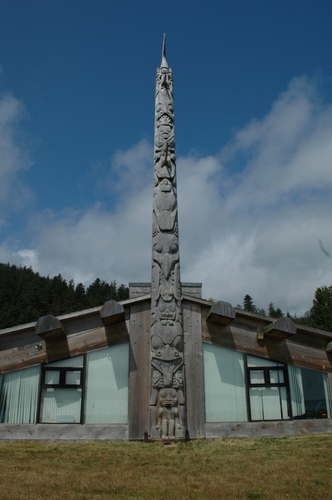
|
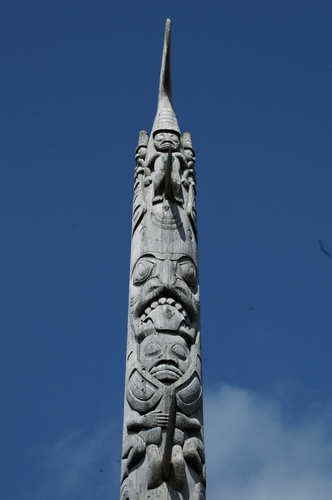
|
The Watchmen The three watchmen protect the house from danger. |
| The Big Bear I really like this photo, but I also have a sketch of this that I am rather proud of as well. |
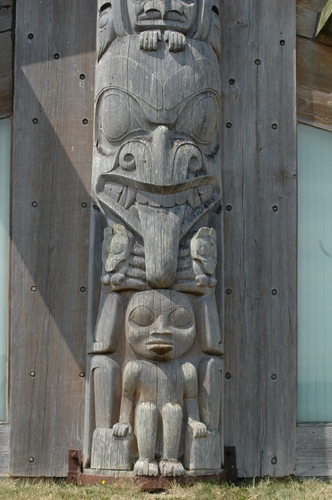
|
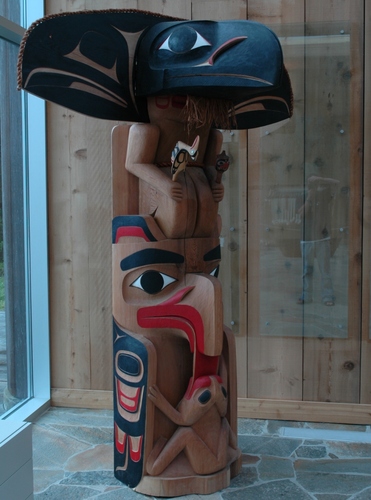
|
Totem in the Haida Gwaii Museum Transforming Raven on top and Eagle with Frog below. |
| Transforming Raven Do not think that culture is rooted in the past, this totem demonstrates new technology as Raven transforms into his human form using the strings worked through the back. |
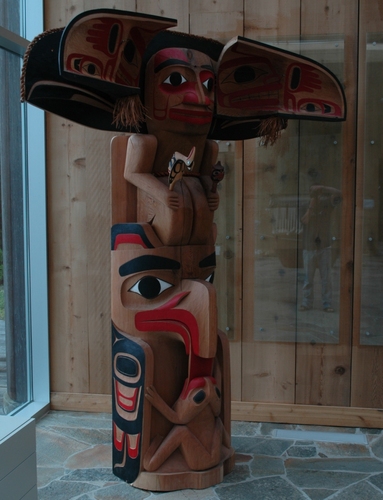
|
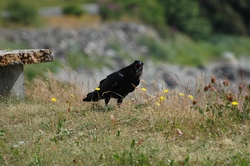
|
The Trickster The Raven is probably the most fantastic of the of the spiritual beings in Haida mythology. He is also one of the two family crests on the island. |
| The Eagle The Eagle clan is the other family crest on the island. Eagle princesses would marry a Raven prince, the prince would then become part of the Eagle family. Princes, or men, always entered the family of their bride. Powerful political alliances were made in this manner. We forget that arranged marriages were the norm for most of the world for most of our history. |
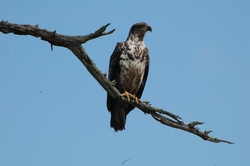
|
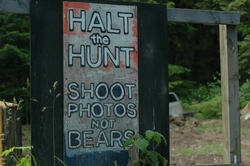
|
Not bad advice No one would ever take business advice from me, but photos don't kill animals and your customers could take as many shots as you can sell. |
| Image title would go here. These are a few of my favorite photographs from my different travels. Feel free to browse them as you like. If you want one click your right mouse button and choose "Save As" from the menu. |
 |
 |
Image title would go here. These are a few of my favorite photographs from my different travels. Feel free to browse them as you like. If you want one click your right mouse button and choose "Save As" from the menu. |
| Image title would go here. These are a few of my favorite photographs from my different travels. Feel free to browse them as you like. If you want one click your right mouse button and choose "Save As" from the menu. |
 |
 |
Image title would go here. These are a few of my favorite photographs from my different travels. Feel free to browse them as you like. If you want one click your right mouse button and choose "Save As" from the menu. |
| Image title would go here. These are a few of my favorite photographs from my different travels. Feel free to browse them as you like. If you want one click your right mouse button and choose "Save As" from the menu. |
 |